AP Physics 2 Ultimate Guide
1/203
Earn XP
Description and Tags
Name | Mastery | Learn | Test | Matching | Spaced |
|---|
No study sessions yet.
204 Terms
Fluids
Substances which can flow.
Density
Mass per unit volume of a substance
S.I. Units of Density
kg/m³
CGS unit of density
g/cc
Pressure
Magnitude of normal force acting per unit area
S.I. Units of Pressure
Pascal
Hydrostatic pressure
Pressure due to liquid
Factors that hydrostatic pressure depends on
Density of liquid and depth below the surface
What principle does buoyancy use?
Archimedes Principle
Buoyancy
If a body is fully or partially immersed in a fluid, it experiences an upward force due to the fluid called buoyant force.
An object with a mass of 150 kg and a volume of 0.75 m3 is floating in ethyl alcohol, whose density is 800 kg/m3. What fraction of the object’s volume is above the surface of the fluid?
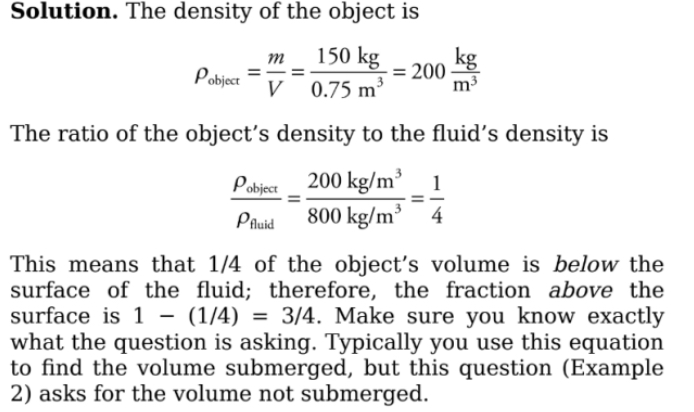
Volume Flow Rate
Volume of fluid that passes through a particular point per unit of time.
Formula for volume flow rate
F = Av
A = cross-sectional area
v=flow speed
Continuity equation
The density of fluid is constant. Thus, A1V1 = A2V2.
A circular pipe of non-uniform diameter carries water. At one point in the pipe, the radius is 2 cm and the flow speed is 6m/s. What is the flow speed at a point where the pipe constricts to a radius of 1 cm?
Bernoulli’s effect
At comparable heights, the pressure is lower where the flow speed is greater.
Bernoulli’s Equation

Buoyancy diagram for object floating in liquid.
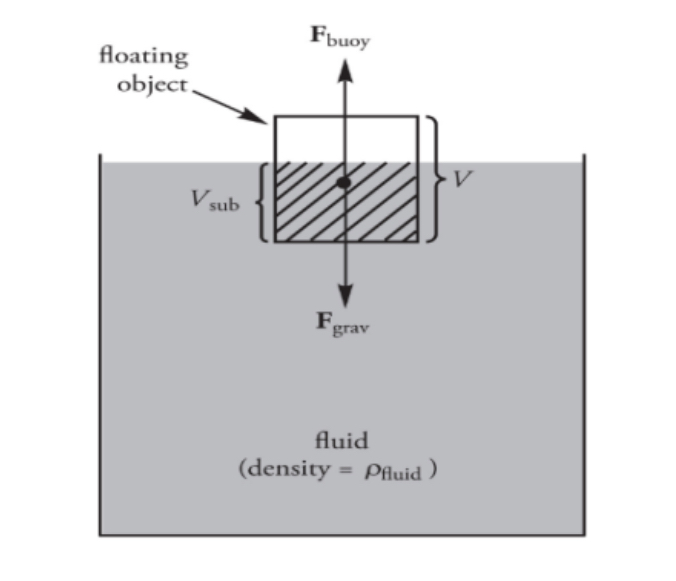
Practical units for pressure
atm, bar, torr
A vertical column made of cement has a base area of 0.5 m2. If its height is 2 m, and the density of cement is 3000 kg/m3, how much pressure does this column exert on the ground?

SI unit for Volume Flow Rate
m³/s
A circular pipe of non-uniform diameter carries water. At one point in the pipe, the radius is 2 cm and the flow speed is 6m/s. What is the volume flow rate?

What does Bernoulli’s Equation assume for the conservation of energy in fluids?
The fluid is incompressible.
The fluid’s viscosity is negligible.
The fluid is streamlined.
Bernoulli’s Equation

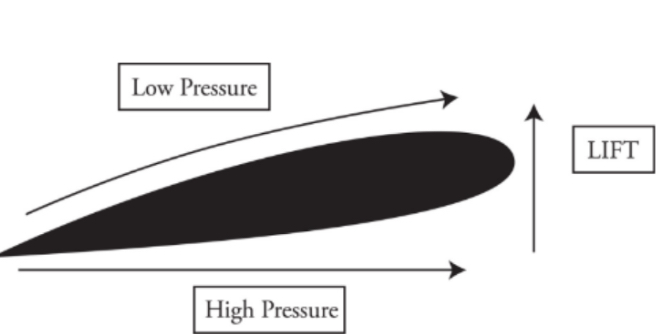
Explain how airflow affects the airplane wing in the image and helps it fly.
The air on the bottom has greater pressure and pushes up on the wing, giving the airplane lift force.
Heat
Thermal energy is transmitted from one body to another.
Energy in transit.
Temperature
It is a measure of an object’s internal energy.
Kinetic Theory of Gases
It relates to the macroscopic properties of gases such as pressure, temperature, etc.
Every gas consists of small particles known as molecules.
The gas molecules are identical but different from those of another gas.
The volume of molecules is negligible compared to the volume of gas.
The density of a gas is constant at all points.
Consequently, pressure is exerted by gas molecules on the walls of the container.
No attractive or repulsive force exists between the gas molecules.
The Ideal Gas Law
Pv = nRT
P = pressure
V = volume
n = no. of moles
R = Gas constant
T = temperature
Average Kinetic Energy
The pressure exerted by N molecules of gas in a container is related to the average kinetic energy.
K avg = 3/2 kb T
K avg = average kinetic energy
kb = Boltzmann’s constant
T = temperature
Room mean square velocity
It gives us a type of average speed that is easy to calculate from the temperature of the gas.
vrms = √3 kb T/ m
vrms = root mean square velocity
kb = Boltzmann’s constant
T = temperature
m = mass
The Maxell-Boltzmann Distribution
The Kinetic theory of gases applies to a large number of particles.
Some molecules will be moving faster than average and some much slower.
Heat Engines
It is a device which uses heat to produce useful work.
Convection
The movement caused within a fluid by the tendency of hotter and therefore less dense material to rise, and colder, denser material to sink under the influence of gravity, which consequently results in transfer of heat.
Radiation
Emission or transmission of energy in the form of waves or particles through space or through a material medium.
Zeroth Law of Thermodynamics
If objects 1 and 2 are in thermal equilibrium with Object 3, then Objects 1 and 2 are in thermal equilibrium with each other.
First Law of Thermodynamics
It is a special case of the law of conservation of energy that describes processes in which only internal energy changes and the only energy transfers are by heat and work.
∆ U = Q + W
Q = heat added
W = work done by the system
∆ U = change in internal energy
Work done
It is used to calculate work done
Isothermal Process
Temperature remains constant
Adiabatic Process
No transfer of heat
Isobaric Process
Pressure remains constant
Isochoric Process
Volume remains constant
Second Law of Thermodynamics
It describes how systems evolve over time.
Entropy
It is associated with a state of randomness, disorder, or uncertainty
Conduction
Heat conducts from one point to another only if there is a temperature difference between the two objects.
Electric Charge
In an isolated system, the charge is always conserved.
Protons and electrons have a quality called electric charge.
The charge is invariant in nature.
The charge is quantized.
(Q = n e)
e = 1.6 * 10^-19 C
n = no. of electrons
Q = charge
Ionization
Coulomb’s Law
The electric force between two particles with charges q1 and q2 separated by distance r has a magnitude by the equation:
F = Kq1q2/r^2
F = force
K = coulomb’s constant
q1 and q2 = charges
r = distance between the charges
Addition of forces
Consider three point charges: q1, q2, and q3. The total electric force acting on, say, is simply the sum of F1-on-2, the electric force on q2 due to q1, and F3-on-2, the electric force on q2 due to q3:
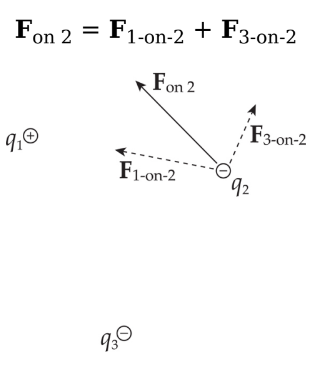
Electric Field
The space is surrounded by a charge in which another charged particle experiences the force.
E = F on q/ q
It describes the electric field vector from the force vector on a positive charge.
Electric field due to a point charge
The electric field surrounding the point charge is:
E = 1/4πε0 * Q/r^2
E = electric field
Q = charger = distance between charges
ε0 = permittivity of free space
Three types of electric field
Radial field
It is generated by a collection of point charges.
An infinite sheet of charge.
electric field lines
The electric fields follow the same addition properties as the electric force.
The electric field lines never cross.
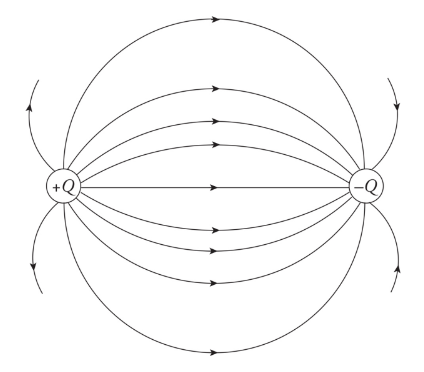
The uniform electric field
A lot of problems deal with the uniform electric field. The field may be taken as uniform at least in the middle. The uniform field just signifies the constant force.
Conductors
Materials which allow the flow of excess charge without resisting it.
Insulators
Materials that resist the flow of electrons.
Charging by friction
It involves rubbing the insulator against another material, thereby stripping electrons from one to another material.
Charging through conduction
When we connect two conductors charge flows from one to another until the potential of both the conductors becomes the same.
Charging through induction
The process of charging by induction may be used to redistribute charges among a pair of neutrally charged spheres.
If the sphere is an insulator made up of glass
There aren’t any free electrons. The atoms make up the sphere will become polarised.
charge of proton
positive
charge of electron
negative
law of charges
the directions of the electric forces on the charges of mutual interaction; like charges repel, opposite charges attract.
net charge
an object with an excess of positive or negative charges
electrostatic charging
accomplished by Friction, Contact, Induction, or Polarization
Charging by Polarization
Charging by Polarization
How do objects become charged?
By gaining/losing electrons
Electric charge is always _______.
Conserved
What is the numerical value of one charge?
1 e = 1.6 x 10^-19 Coulombs
The SI unit of a charge is in ______.
coulombs
What happens when an insulator is charged?
Only the small spot which was directly contacted with a charge remains charged.
What is the name of materials that contain properties somewhere between conductors and insulators?
semiconductors
A dipole consists of:
two equal and opposite charged
In what direction to field lines go?
From positive to negative charges ALWAYS
What indicated field strength?
The density of field lines
What do few field lines between charges indicate?
a weak field
Which one of the following rules, laws, or principles describes how the net electric charge of an isolated system undergoing any process remains constant?
law of conservation of electric charge
Electrical Potential Energy
We is the work done by the electric force, then the change in the charge’s electrical potential energy is defined by:
Ue = electrical potential energy
We = work done by electric force

Electrical Potential Energy from a point charge
Electrical potential energy required to move along the field lines surrounding a point charge is given by:
q1 and q2 = charges
e0 = permeability of free space
Ue = electrical potential energy
r = distance

Electric Potential
Electric potential is the electric potential energy per unit of charge at a point in an electric field, measured in volts (V). It's the work done per unit charge in bringing a test charge from infinity to that point.
V = U/q

Electric Potential Energy from a point charge
Consider the electric field created by a point source charge Q. If a charge moves from a distance rA to a distance rB from Q, then the change in the potential energy is:
Ub and Ua = electrical potential energies for a and b
ra and rb = distances for a and b
e0 = permeability of free space
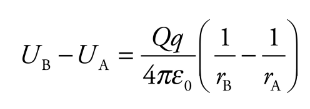
Equipotential Surface
An equipotential surface is a surface in a region of space where every point on the surface is at the same potential. In other words, no work is required to move a charge along an equipotential surface. Equipotential surfaces are perpendicular to electric field lines and can be used to visualize the electric field in a given region.
Addition of electric potential
V = kQ/r
V = electric potential energy
q = point charger = distance between any point around the charge to the point charge
k = Coulomb constant; k = 9.0 × 109 N
Equipotential Curve
Equipotential curves are curves of constant elevation. If you walk along any of the contour lines and you neither ascend nor descend, then the curve is known as the equipotential curve.
Equipotential Map
A drawing of several equipotential curves at various values of the potential for a charge distribution is called an equipotential map.
Capacitor
Two conductors, separated by some distance carry equal but opposite charges +Q and -Q. The pair comprises a system called a capacitor.
Parallel-Plate Capacitor
The capacitor is in the form of parallel metal plates or sheets.
Capacitance
The capacitance measures the capacity for holding charge.
C = κε₀A/d (k = dielectric constant)
Fringing fields
Fringing fields extend beyond conductor or magnetic material edges. They weaken as the distance from the edge increases. They're important in device design but can cause interference and affect performance.
energy stored in capacitor
The energy stored in a capacitor can be calculated using the formula
Uc = ½QV = ½CV² where
U is the energy stored in joules, C is the capacitance of the capacitor in farads and V is the voltage across the capacitor in volts.
Dielectric
To keep the plates of the capacitor apart they are filled with dielectric which increases the capacitance of the capacitor.
The amount of work done by a uniform electric field
W = q E d
W = work done
q = charge
E = electric field
d = distance
A dielectric always _______ the capacitance of a capacitor
increases
the __________ of the capacitance of a collection of capacitors in series is found by adding the reciprocals of the individual capacitances
reciprocal
Collection of capacitors is said to be in ______ if they all share the same charge magnitude
series
The equivalent capacitance of a collection of capacitors in parallel is found by _______ the individual capacitances
adding
The equivalent capacitance of a collection of capacitors in parallel is found by _______ the individual capacitances
parallel
1 C/V = ?
1 Farad
Ratio of charge to potential difference (C=Q/∆V)
capacitance
Magnitude of the potential difference between two plates of a distance d
∆V = -Ed